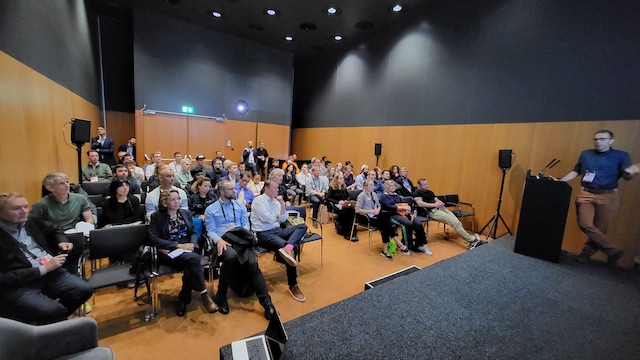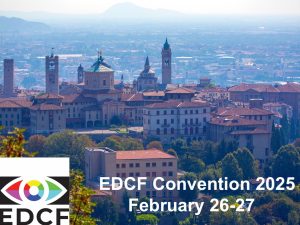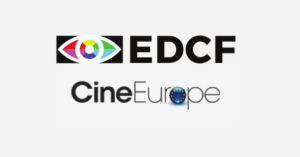Industry insights and technology trends for the big screen
For the second time after the pandemic the EDCF’s long-standing cinema seminar “Cinema is looking forward to a changing future“ returned to IBC 2023. The session chaired by Julian Pinn, Vice President of the EDCF, was well received by the audience and focused on current trends and tendencies in the cinema sector: From a general market overview via laser projection and HDR to streaming and sustainability.

In her welcome greeting Cathy Huis in’t Veld-Esser, President of the EDCF, stressed that the EDCF had become a “trusted bridge to Hollywood“. In the future, she said, it was about to strengthen the cooperation with other industry stakeholders to further solidify the EDCF’s role as an industry enabler.
One important question was the overall status quo of the industry. More precisely, how did the cinema market recover after the pandemic? David Hancock, Omdia, presented current facts and figures. According to his statement, the industry had recovered, but in parts this process had been very slow. The industry has not yet returned to the level it was at before the pandemic. It would therefore take some time before the industry could regain its former strength.
Although all signs for this year pointed to growth -box office forecast for 2023 is around 33 billion dollars- but the strikes of screenwriters and actors are putting enormous pressure on the major studios and it is to be feared that a continuation of the labour disputes will have a severe impact on the development of the industry, which is likely to be reflected in next year’s results. [Note by the editor: By the time this article is written, the Writers Guild of America had come to an agreement with the Studios. However, the actors’ strike continues so “much of Hollywood will remain shut down“ as a recent article in the New York times reveals.]
Another concerning development is the slowly growing number of cinema screens. David underlined the importance of a sound basis of modern cinema venues to attract new target groups.
Despite all the obstacles, he does not see the whole industry at risk: “Cinema is of a global relevance. A relevance that other forms of entertainment do not have“.
The EDCF’s role as an enabler for the cinema industry was underpinned by Cathy Huis in’t Veld-Esser’s report on the EDCF Problem Resolution Round Table hosted at Cine Europe in Barcelona in June for the forth time. It aimed at pointing out common technical challenges in cinema operations and discussing potential solutions.
One of the most pressing problems of the cinema industry, as in other sectors, is the shortage of skilled workers. This is because technical advancements demand deeper IT expertise that complements cinema-specific knowledge. A skillset not many potential candidates have. The pandemic worsened the situation as many qualified workers left the industry for good. Cathy stated that cinema might not be “as cool as it used to be“ and that other sectors might be considered more attractive by new talent. It therefore required a lot of effort to win and keep new employees, she concluded.
Other challenges include malfunctioning technology, cyber security, and disposal of old equipment. For alternative content, such as live events, sound problems are common. These are due to the fact that the sound mix was created specifically for broadcast. In this context, recommendations for a cinema environment could be developed in collaboration with the Event Cinema Association to remedy the situation.
Cross-sector cooperation among all industry players -associations, distributors, exhibitors, manufacturers- is also needed to address the other challenges, especially the shortage of skilled workers. She stated that it was about raising awareness and making room for new ideas. According to her statement this was where the particular strength of the EDCF lies: To act as a connecting element when addressing these complex challenges. Cathy invited the industry peers to become actively involved: “The EDCF is a forum, questions or remarks are always welcome.“
Better Images: Laser, HDR
One key topic of recent years has been laser projection. The first laser-based projectors were already introduced in 2014. According to Tom Bert, Barco, around 95 percent of all devices shipped worldwide today are laser projectors. More than 30 percent of all cinemas have converted their projection systems to laser. He expects that an overall switch to laser projection is only a matter of time.

While exhibitors and some wealthy individuals are already benefiting from the advantages of laser projection, post production facilities are still working entirely lamp-based. Tom stated that this was due to the different requirements of both areas.
For cinemas, the total cost of ownership or TCO along the whole life cycle of a projector is key: Laser projection is known for its longevity and, what’s more, there are no more lamp changes required. In post production, to the contrary, image quality is the only indicator that counts. And that is what both lamp-based and laser-based projectors offer.
Another important aspect for cinema operations is the possibility to automate certain workflows and to integrate the projector in existing environments. Post production focuses on the flexibility regarding content and play-out formats.
Last but not least, cinemas are to run maintenance-free, if possible. Here too, the laser projector has an edge over its lamp-based competition. For post production and its understanding of quality, however, it does not matter how much maintenance or calibration efforts are needed to run a projector.
However, the days of Xenon in post production seem to be numbered: In three to five years from now, post production is also supposed to swap to laser, Tom said. This was because they also profited from the possibilities of laser projection, e.g. in view of HDR content, which was now ready to conquer the cinemas.
Tom’s colleague Jean-Philippe Jacquemin further elaborated the subject of HDR for cinemas. He stated that while nearly all new TV devices sold and many existing smartphones were HDR-ready and streaming services already provided HDR content, cinema so far only knew Extended Dynamic Range, i.e., Dolby Cinema and Imax.
But the outlook for HDR in a cinema environment seems promising. In April this year, the DCI published a High Dynamic Range D-Cinema Addendum. And, more recently, the Compliance Test Plan CTP Version 1.4 as of 18. Juli 2023 also included HDR.
Barco developed the HDR Lightsteering technology; and also the manufacturer’s LED walls can be converted to cater for HDR content. In addition, the company and other industry players like ARRI and Filmlight are actively involved in HDR4EU, a project funded by the European Commission that aims at establishing an end-to-end HDR workflow for the cinema.
At Cannes film festival, Barco had already showcased some examples of HDR content using its Lightsteering technology. According to Jean-Philippe, HDR is not only suitable for action content but can add more details to calmer films. In either case, the workflows -from acquisition via editing to play-out- are ready.
Especially for HDR in post production and color grading Barco developed HDR scopes. The product is forecast to launch in 2024.
These days, thanks to the advancements of Chat GPT and similar services, it is impossible not to discuss AI in a media environment. Philipp Eibl, Fraunhofer IIS, talked about AI-based generation of subtitles in cloud-based workflows. These cloud services are controlled via app or a desktop device.
AI-based video transcription can be used for a variety of tasks, such as speaker diarization or translation. Different services can be combined with each other as desired, so that the preferred partners can be used in each case.
The advantages of using the cloud for these post-production processes include outsourcing compute-intensive processes, scalability and maintenance. It is possible to work with a private or public cloud; and remote collaboration is also simplified.
Trending: Streaming and Sustainability
How could cinemas profit from the streaming boom? Or could they even become a part of a streaming platform? An idea Oleg Berezin raised in his keynote and mentioned the many ups and downs of commercial cinema over the last decades. He stated that cinema was experiencing another downswing that started in mid-2010s due to the rapidly changing media consumption. Exhibitors, he continued, were facing the problem that they aren’t the content owerns and that these often treated cinemas as an object rather than a relevant market subject.
As a result of these current conditions, according to Oleg, some form of market consolidation would need to take place. The industry required new ideas and new business models to regain market power. This could for example result in connecting a certain cinema or a whole circuit to one streaming platform.
In doing so, studios would be able to create a whole eco system (e.g., with cinemas, shops, theme parks, VOD services). Cinemas would continue to provide content for the big screen (blockbusters), but use a variety of tools such as audience data, the advertising power of platforms, etc., for advertising and customer engagement.
Content providers platform owners would be interested in investing in technical innovations and in the cinema business growth. That is because cinemas would once again become “profit centers” for them, Oleg concluded.
Andrew Grosso and Jess Carlin, pickaxe, summarised some “lessons learned” by cinemas and other entertainment providers during the pandemic. They said that one of the most important factors was that the cinema industry, like many other industries, naturally presumed that audiences would remain loyal. But this was wrong; “quiet quitting” had long since reached the media and entertainment industry.
The pandemic had also changed other entertainment forms like sports and live productions. For example, during the first phase of the lockdown, without current reporting of sporting events, the audience streamed sports content of previous events (highlights, historic finals, etc.) as a replacement. But even when sporting events started again without an audience, many spectators did not return – ratings, e.g. for the NBA, had been reduced by half. Live subscriptions for the finals (around ten mission pre-pandemics) declined to four million and have still not returned to their old level.
Theatres and concerts also experienced significant declines. Subscriptions, for example, dropped by 50 percent during the pandemic. More specifically for musicals, about 17 percent of the audience went to musicals pre-Covid, but only ten percent post-Covid. Production by larger regional theaters dropped by an average of 20 percent.
But even in streaming, not all that glitters is gold. After the boom of streaming platforms from 2015 onwards, streaming has reached his peak for a few years. Jess and Andrew pointed out that there were too many offers, people felt confused. The pandemic had increased the need for live events and face-to-face encounters. So the chances for the cinema business were not as bad, even if, for example, around 17 percent of Americans no longer go to the cinema for cost reasons, they said.
David Hancock then opened the presentations on sustainability in a cinema environment. For him, the cinema industry’s digitisation was already a first important step towards climate neutrality. By comparison, 1.2 million miles (or 1.93 million kilometres) of celluloid were used to produce film prints in 2008!
He continued that, unfortunately, also the number of films produced also increased the carbon footprint. Particularly significant in an average production are, for example, transport (approx. 51 percent of CO2, of which 70 percent attributed to road and rail transport and 30 percent to air transport), electricity and gas consumption (34 percent in total, of which 30 percent attributed to production) and diesel generators (15 percent).
The cinema itself also produces CO2 emissions in many areas. Possible climate-friendly measures include using an HVAC system and LED lighting, converting to laser projection and switching to paperless ticketing or plastic-free cups and cutlery for the concessions area.
In his keynote, Cedric Lejeune, Holli, discussed how cinemas can develop a sustainability strategy. In this context, he first described in which three areas greenhouse gas emissions might be produced in cinema operations, i. e., due to HVAC leakage, energy consumption or indirectly, due to manufacturing products, preparing food, or logistics and transport. According to his statement, the third (indirect) area accounts for 80 to 95 percent of a company’s emissions.
But to understand which areas may be producing GHG emissions, cinemas need to analyse a lot of data, for example projection equipment, TMS, building management, PoS, ERP systems, subscriptions, discount cards, and more.
Potential measures to reduce a cinema’s CO2 footprint might include automatic equipment control (on/off/standby) based on the number of tickets sold or managing the air flow based on the number of seats booked in an auditorium. Other options might be to dim the light or to introduce discounts for people travelling with public transport or groups that share a car.
Radoslav Markov, Institute of Mathematics and Informatics Bulgarian Academy of Sciences, concluded the EDCF seminar session with a keynote on sustainability in Europe and related challenges.
He explained the strategy behind the “European Green Deal,” which aims to make the European continent the first to become climate-neutral. Its cornerstones are to reduce energy and raw material consumption and to produce less waste.
He also addressed the topic of consumer rights within the EU, the right to repair in particular, which gives European consumers rights and instruments beyond the legal warranty that make “repair” a simple and available option.
Note: A German version of this report can be found here: https://fktg.org/ibc-2023-edcf-seminar-zur-kinotechnik



